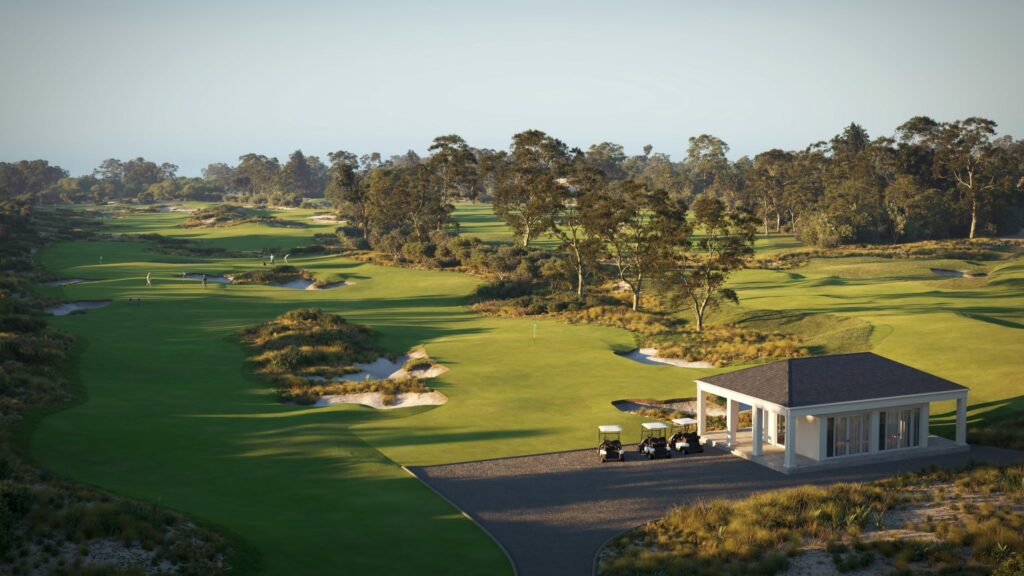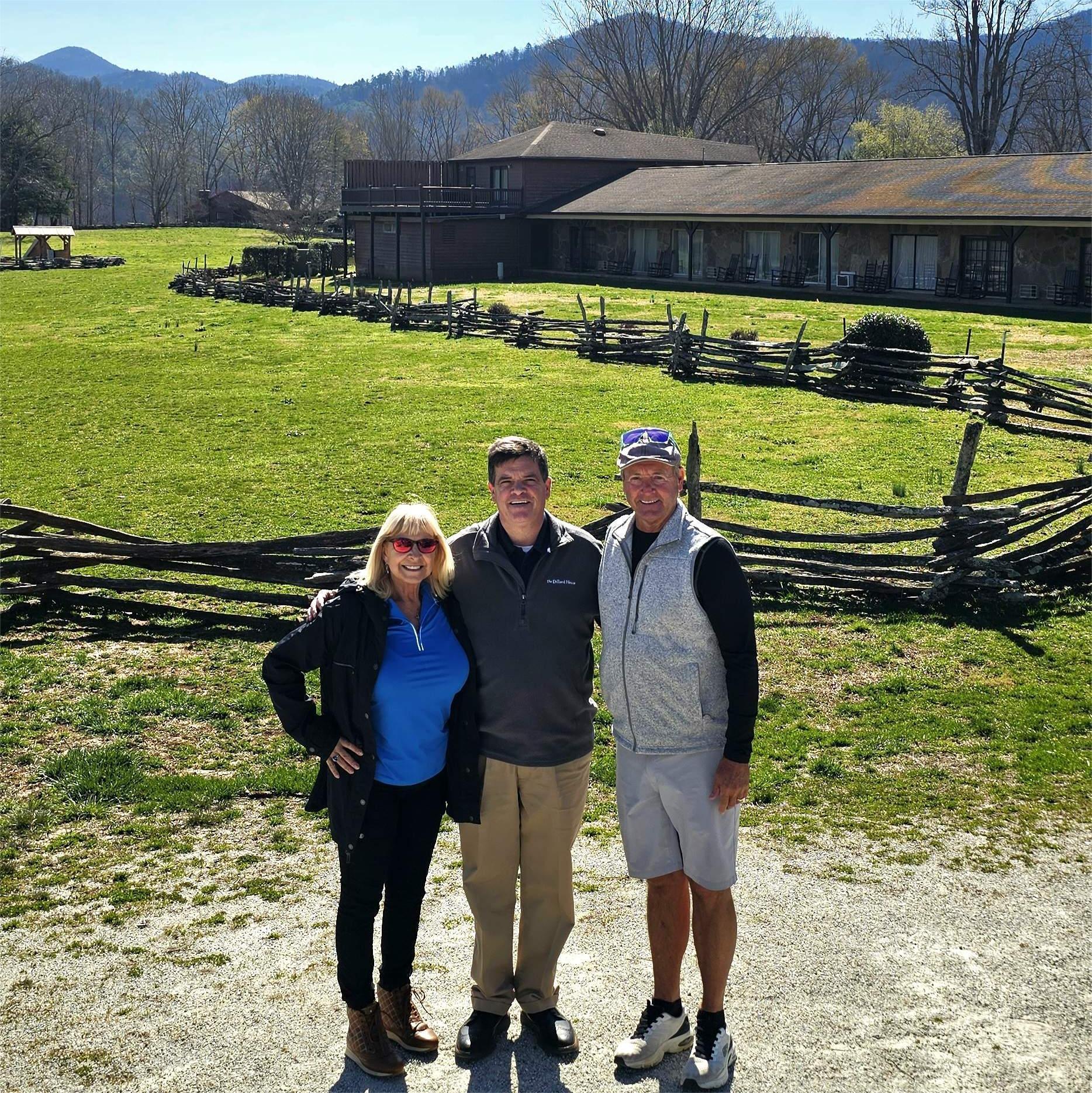Mike Cocking
Director
Ogilvy, Cocking & Mead (OCM)
Interview with Matt Ward
BACKGROUND:
From the age of 11, I wanted to be a professional golfer and whilst I eventually achieved that goal – albeit briefly – I quickly realized playing for a living wasn’t for me. With a passion for design and degree in engineering I pursued a career as a golf course architect. When my home course was being renovated, I was lucky enough to get a part time job with the company who had been awarded the work.
Ashley (Mead) started at the same time with the same firm, which means we’ve now worked with each other as design partners for over 20 years. In 2010 we started OCM along with Geoff Ogilvy, who I had known for a similar amount of time from junior golf days. We are fortunate to work with many well-known clubs around Australia and have completed several high-profile projects in recent years, including Peninsula Kingswood; Lonsdale Links – our ode to the templates of Seth Raynor and CB Macdonald; and, Sandringham Golf Course, which is a publicly accessible sandbelt design.
In the last decade we’ve become better known overseas – particularly in America. Our first commission at Shady Oaks Country Club (Fort Worth, Texas) was completed in 2019. Following the success at Shady, we were awarded the redesign of Course #3 at Medinah Country Club plus new projects in Minnesota and Georgia.

THE COCKING STORY:
As a teenager, I worked in a retail golf shop as a part time job. One day my boss bought in one of Tom Doak’s early copies of the confidential guide and kindly let me borrow it — I might have even photocopied a few pages. It was a turning point for me.
This was pre-internet so to that point most course reviews were the type you would find in magazines which usually read like paid advertisements rather than critical reviews. Tom’s book was totally unique with his ruthless appraisals of many of the world’s best courses. It also opened my eyes to the whole notion of golf course architecture which to that point I’m not sure I really understood.
Sure, I knew that playing Kingston Heath or Royal Melbourne was a special experience, but it was hard to put my finger on exactly what made them so good, beyond of course the things that I could understand like conditioning or aesthetics. Tom’s book introduced me to the art of golf course design and proved to be the beginning of a journey which I fortunately still find myself on to this day.
***
You are in the creative business — how much of golf architecture is art and how much is science?
I think of golf architecture more as an art-form. Sure, there are some elements that have their roots in science, particularly things like agronomy, irrigation, drainage and so on, but I would say the skill in laying out and visualizing golf holes is more art than science.
The scientific part of the profession can be learnt but a lot of the visualization of seeing golf holes on a property or judging aesthetics is something that is not so easily learnt — you tend to find people either see it or they don’t.
From a creative point of view, I think there is also danger in taking too much of a scientific approach in designing golf holes as they might end up becoming a bit too formulaic. Certainly, you would likely miss out on the opportunity to create unique holes, or those with offering a touch of quirk, which are often some of my favorites.
What distinguishes OCM from others in the golf architecture field?
One of our strengths is our collaborative approach. Geoff, Ashley, and I all come from slightly different backgrounds and have different skills, but they complement each other well and I guess makes for a unique creative structure. Then if you include our staff – shapers and project managers – it’s even more diverse.
In America it may not be that uncommon for design firms to build their own work but we are the only firm in Australia that work this way. We pride ourselves on having the ability to take a project from the very first concept sketch right through design, construction and even into grow-in and maintenance in some cases.

Among all architects — whether alive or dead — who are the individuals you hold in the highest regard and why?
Growing up in Melbourne it’s hard not to be enamored by the work of Alister Mackenzie. He completely changed the direction of golf course design in Australia in the 1920’s and influenced our best courses here, including Royal Melbourne, Kingston Heath, Metropolitan, Victoria, New South Wales and Royal Adelaide. He also visited and made recommendations to another dozen or so courses. Incredible to think he barely spent 10 weeks here.
Mackenzie’s approach was entirely different to anything present in Australia at that time. In a country where most courses had been laid out by ex-professional golfers and were aligned more toward the penal school of design, Mackenzie’s approach was a breath of fresh air. His designs introduced the concept of wider fairways, reduced the amount of rough and then bunkers were added to create strategic interest. Play close to trouble and gain a reward. It was quite revolutionary.
Mackenzie was also a genius at routing golf holes. You only need to look closely at what he did at Royal Melbourne to understand why — particularly stretches of holes like the 3rd through 6th on the West course.
Your firm received the job assignment to update Medinah #3 in Illinois. The layout has gone through countless changes over the years and is now doing so again. What is your firm’s goal for the club and how will that both, correct and surpass, all past efforts attempted?
Medinah has a rich and interesting history, and an enjoyable part of the process has been diving through all the old aerials, photos and plans in the clubs’ archives.
Part of the review process has resulted in finding a few elements which we’re keen to see restored. We found a few incredible photos from the early 30’s which showed some really bold and artistic bunkers on the 3rd and 4th holes. These are pretty much being put back just like the photos we found. The more natural looking hazards from this era will then also serve as the model for the new bunkering on the course.
Like so many golden age courses the early images also showed much wider fairways. This is a key part of the new design…creating a little more width. As a member’s course that plays host to major events it’s important to try and balance the ideal of being playable for average golfer yet still challenging and interesting for the elite. On the current course that balance is a little out of kilter. The combination of narrow fairways, plus of course its length, has made it an incredibly difficult members course and yet even at almost 7700 yards, its relatively tame for the professionals.
Perhaps more than anything though, we’d like to see more variety and interest with the design. We like holes with lots of options, that can vary day to day as the pin position moves around or the weather changes.

At Medinah #3 OCM is proposing six new holes starting with the soon-to-be former par-3 13th hole which played a major role in past major events there. How were you able to convey to senior leadership at the club that your new hole proposal was a central element in bringing back to the forefront the club?
Course #3 is so fortunate to have a feature like Lake Kadijah and a number of holes playing close to the water. Along with the beautiful old oaks and undulating ground it helps create a unique look and feel to the golf course. But it struck us that the Lake doesn’t really come into play for the better golfer. Nor does it offer much interest as a strategic hazard, like so many of the great holes that play around water. In fact, the water really just penalizes the average golfer, with forced carries on 2, 13, 14 and 17.
On top of that there were a couple of elements with the design of the last six that we felt could be improved.
The 13th and 17th are both very similar holes playing alongside each other, both over water and even played in the same direction. We also thought there was a chance to create a world class short par four and to be honest that was one of the areas where the idea of re-routing started. Every time we looked at the 17th our eyes were drawn along the bank to the right of the green and over towards the 14th tees which set the lake edge on a lovely diagonal and reminded us of a Cape style short par-4.
Then the more we looked at the last six, the more we felt there was a chance to create an even more memorable and dramatic finish to the course. Aside from the quality of the holes, one of the things we also liked was how much action would take place around the lake for the final few holes, and with the area shaped like a natural amphitheater, it could make for a pretty stunning conclusion to the round or a tournament.
A number of people have viewed the existing Medinah #3 as arguably, a predictable course lined extensively with hardwoods of one type or the other. How does OCM’s involvement change that assessment and what type of “new” course do you see emerging?
Course #3 has evolved over the decades and I think its fair to say, many of the changes have been influenced by tournament golf and the notion of trying to make it harder for the professionals. Rough was added, fairways were narrowed, trees were planted on the corners of dogleg holes and some greens and bunkers altered to try and influence the games elite. The result is a course that’s very difficult for the average member and yet even at almost 7700 yards, the best the players in the world aren’t finding it overly difficult.
This is also contradictory to what we think makes for the most interesting golf. We prefer to see wider fairways and more short grass so driving doesn’t just become a test of execution but gives the player options and forces them to think about where to are best to hit to. Then through the positioning of bunkers around the green, the tilt of the putting surface and firmness, you can disadvantage those who have hit to the wrong side of the fairway while rewarding those who have played to the correct side.
Bunkers or other ground hazards are then used to defend the ideal line back in the fairway, forcing golfers into making a decision about how much risk and how close to the hazards they wish to play, in order to gain a reward. These concepts pretty much define strategic design and ensure holes are playable and interesting for a wide range of golfers. They aren’t necessarily new ideas. Its how the best courses in the game were designed 100 years ago and we believe are just as relevant today as it was then.

The USGA and R&A issued a joint statement in 2021 emphasizing continued gains in the distances golf balls travel is not healthy for golf and they plan on doing something — could be as early as this year. What’s your assessment of the assessment on how this delicate subject should be handled?
The technological advances haven’t changed the game so much for the average golfer and arguably the larger heads, lightweight shafts and golf ball have added to the enjoyment for the masses. But at the professional end it’s become a little silly and 350 yards drives have forced the great old courses to add more and more length to remain relevant. The sad thing is that a lot of these great old courses simply don’t have the room to stretch holes and either result in not being able to host events or if they do, the game becomes such a distortion of how the course was meant to be played it becomes sad to watch.
I think the easiest thing to do is to place some limitations on the ball to restrict its flight. Perhaps also the driver head size comes down a little for professionals. I grew up in the era of persimmon and it’s interesting that for guys my age our swing speeds are generally lower because I think our game adapted around the fear of a miss hit. Driver swings had to be a little more controlled with the smaller wooden blocks as they weren’t that easy to hit. But watching the young guys that have grown up with larger heads it seems that because they never had a fear of missing the ball, they learn from an early age to maximize their swing speed. I think this has something to do with the issue just as much as the ball.
If you could change one thing in golf unilaterally — what would it be and why?
The golf ball for the reasons I just mentioned.
Growing the game has become the catch-all phrase mouthed by many in the broader golf industry. Define the term and what do you see as being the specific roadmap that the key stakeholders within golf should follow?
For me growing the game is all about introducing new golfers to the game – especially those who sit outside the demographic typically associated with golf.
A big part of this is creating ‘non-traditional’ variations of the game that appeal to these broader groups. For many, the standard 18-hole version of the game isn’t attractive. Its long and can be intimidating if you don’t know much about the game. If you’re by yourself its unnerving just turning up and trying to join a group when you’ve barely ever swung a club.
So other forms of the game are important to help break down these barriers. More casual, less pretentious, quicker and especially in the case of getting kids interested, games that appeal to those with a shorter attention span. Mini-golf, Himalayas putting courses, Topgolf, short courses, pitch and putt, 9-and-12-hole courses and the concept of teeing it forward are all fantastic pathways into the game and brilliant ways to break down the misconceptions of what golf’ is.
Best advice you ever received — what was it and who was it from?
My dad taught me a great lesson many years ago. He was an art teacher and a great artist who taught me a lot about drawing, painting, art history and things like perspective and balance which are just as important in art as they are in golf course design.
One of the lessons that has lasted with me was knowing when to stop. When drawing or painting I would often keep fiddling with a piece…adding nothing and only running the risk of ruining what was on the page. He taught me to have confidence in what had been created and knowing when to put the pencil down. I think the same goes for golf course design.
***
For more info go to: www.ocm.golf
*Featured Image: Kingston Heath Rendering #3 (Harris Kalinka)













